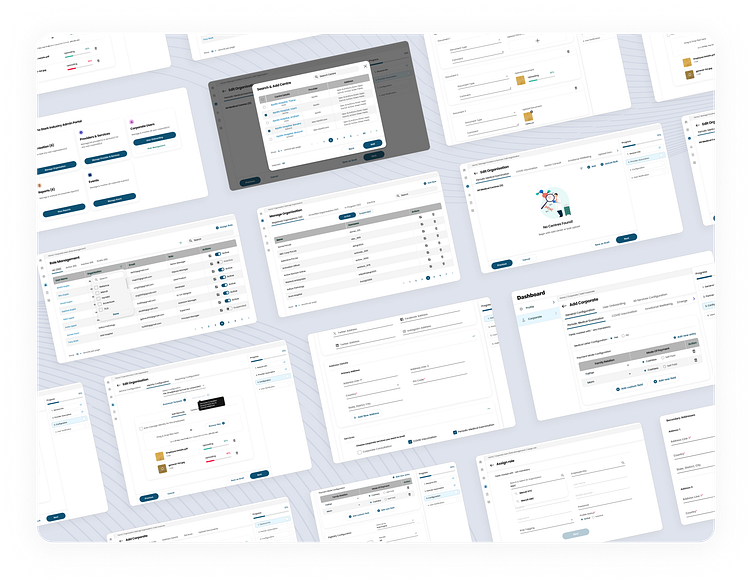SaaS Admin Portal
I conceptualised the UXUI of this admin portal using a lean design thinking approach & balanced aesthetics with feasibility leveraging the design heuristic fundamentals as its backbone. This comprehensive SaaS solution empowers administrators across B2B and B2C industries to manage corporate roles, providers, services, users, and organizations with unparalleled efficiency and ease.
Understanding the Challenge :-
Traditional corporate administration often involves a multitude of disconnected systems, cumbersome workflows, and limited data visibility. This can lead to errors, inefficiencies, and frustration for administrators.
HCD & Lean Design Thinking in Action :-
1. Empathize: Through research and user interviews, I mapped key pain points faced by corporate administrators as mentioned below.
Complex role management: Difficulty in creating, editing, and deactivating user roles.
Inefficient provider & service management: Lack of a centralized platform to manage provider details and associated services.
Limited user & organization visibility: Difficulty in monitoring user activity and managing organizational structures.
Tedious data manipulation: Time-consuming processes for bulk operations and data updates.
Opaque document status: Difficulty in tracking the status of document uploads and revisions.
Cumbersome data manipulation: Frustrating limitations in adding, editing, and deleting data across various sections.
Overwhelming forms: Long-winded forms hindering data entry and user experience.
Limited flexibility: Inability to save data as drafts and manage multiple records efficiently.
Disparate configuration tools: Scattered configuration options for payments, addresses, services, medical details, and centres.
2. Define
Granular Corporate Role Management: Create, edit, activate/deactivate, and manage corporate roles (including drafts) within a single intuitive interface.
Unified Provider & Service Management: Manage all provider details and associated services from a centralized platform for effortless oversight.
Comprehensive User & Organization Management: View, monitor, and administer corporate users and organizational structures with complete transparency.
Predefined Templates for Bulk Operations: Streamline repetitive tasks with pre-built templates for efficient bulk actions on various data sets.
Clear Document Update Status: Gain real-time insights into document upload and revision status, eliminating confusion for admins.
Seamless Data Manipulation: Effortlessly add, edit, and delete data across various sections within user-friendly data tables.
Stepper Approach for Long-List Forms: Break down lengthy forms into manageable steps for a smoother user experience.
Draft Saving & Multiple Record Management: Save partially completed data as drafts and manage multiple records simultaneously, enhancing flexibility.
Consolidated Configuration Tools: Manage configurations for payments, addresses, services, medical details, and centers from a single, unified interface.
3. Ideate & Test Using Prototype
I explored various design solutions that prioritized efficiency and clarity, emphasizing user needs, intuitive navigation, and a clean aesthetic, post which low-fidelity prototypes were iteratively refined based on user feedback to validate my design choices.
Intuitive role management: Create and manage corporate roles with ease.
Centralized provider & service oversight: Access all provider details and associated services from one location.
Comprehensive user & organization management: Gain complete visibility into users and organizational structures for effortless administration.
Streamlined bulk operations: Utilize pre-built templates to handle repetitive tasks efficiently.
Transparent document status: Stay informed about the status of uploaded documents.
Effortless data manipulation: Add, edit, and delete data with ease.
User-friendly form completion: Navigate complex forms effortlessly using the stepper approach.
Draft management & multi-record flexibility: Save data as drafts and manage multiple records efficiently.
Consolidated configuration tools: Access and manage all configuration options from a single location.
Benefits for Businesses :-
Enhanced administrative efficiency: Streamline repetitive tasks and save valuable time.
Improved data visibility and control: Gain central control over user management, providers, services, and configurations.
Reduced errors: Minimize human error through simplified data manipulation tools.
Increased productivity: Empower admins to focus on strategic tasks, not manual processes.
Scalability and flexibility: Manage complex corporate structures and needs effortlessly.
--------------------------------------------------------------------
Do check out my other work & let me know how y'all found this one ! 😄✌❤
